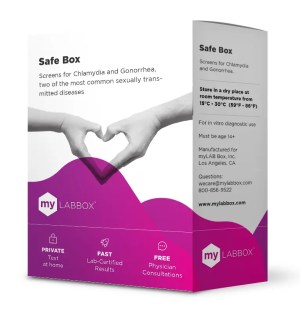How Soon Can You Get Tested for STDs - myLAB Box STD Resources (original) (raw)
Sexually transmitted diseases (STDs) are somewhat of a taboo topic in society, but they’re important to talk about. STDs are extremely common, and the CDC estimates 1 in 5 people in the US have one.
For those who are sexually active, it’s important to practice safe sex and regularly test for STDs. And if you learn you’ve been exposed to one, you may want to take a test immediately.
However, some STDs take several days and even weeks to show up on a test. Consequently, testing too early may cause a false positive, making you think you aren’t infected when you really are.
To keep you informed, in this article, we’ll discuss:
- The importance of testing at the right time
- How soon you can get tested for STDs
- An overview of common symptoms and complications of STDs
- How often you should be tested for STDs
STD Incubation Periods and Their Importance
When you become infected with a disease, you won’t show symptoms immediately. The incubation period is the window between when you’re first exposed and when symptoms begin. All infectious diseases have an incubation period, not just STDs.
Depending on the disease, you may not test positive during the incubation period. As a result, if you test too early, you can get a false negative. However, you may still be contagious, even if you aren’t showing symptoms yet.
When to Test After a Potential Exposure
Each STD has a specific timeline. It’s important to know what these are so that you know when to get tested for STDs after exposure.
Below are some of the most common STDs and the amount of time it takes them to show up on an STD test:
- Chlamydia: 7–21 days
- Genital herpes: 2–21 days
- Gonorrhea: 1–14 days
- Hepatitis A: 15–50 days
- Hepatitis B: 8–22 weeks
- Hepatitis C: 2–26 weeks
- HIV: 2–4 weeks
- Syphilis: Some strains show up after 3 weeks, and others can take years to appear. On average, it takes about 3 months to test positive.
The human papillomavirus (HPV) is the most common sexually transmitted disease in the United States. There is no test to see if you are positive or negative. However, the strains of HPV that are most likely to increase your risk of cervical cancer can be detected with a cervical swab that looks for abnormal cells. This screening is recommended for those with a cervix who are 30 or older.
The Most Common Symptoms Caused by STDs
The symptoms you may experience can vary depending on the STD. You may not have any symptoms at all. However, if you’re experiencing the following signs and symptoms, it’s a good idea to get tested:
- Bumps, sores, or warts on the anus, mouth, penis, or vagina
- Discharge from the penis
- Frequent or painful urination
- Painful sex
- Severe itching and swelling near the penis or vagina
- Vaginal bleeding not caused by a menstrual cycle
- Vaginal discharge with a bad odor or that is a different color than normal or causes irritation
Other symptoms may include:
- Aches and pains
- Chills
- Diarrhea
- Fever
- Night sweats
- Skin rash
- Yellowing of the skin and whites of the eyes (jaundice)
Why STDs Should Never Be Left Undetected and Untreated
While most STDs today have treatments available to help manage or get rid of an STD, an untreated STD can wreak havoc on your body. Some STDs like HIV and syphilis can become deadly, but other STDs can lead to complications as well.
In women or those assigned female at birth (AFAB), untreated STDs may lead to:
- Chronic pelvic pain
- Ectopic pregnancy
- Infertility
- Pelvic inflammatory disease (PID): a serious infection of the female reproductive system that can lead to infertility
In men or those assigned male at birth (AMAB), untreated STDs may cause:
- Infections in the prostate and urethra
- Infertility
- Swollen and sore testicles
If you don’t get tested and don’t seek treatment, you also run the risk of passing an STD on to your sexual partners. This can put their health and lives in jeopardy.
What Does It Mean if an STD Is Dormant?
Some bacterial and viral infections may become dormant, meaning that they remain in your body without causing symptoms. The time during which a virus is dormant is called the latency period. Diseases like chlamydia, hepatitis C, HIV, and syphilis can sometimes have long latency periods, meaning you may contract the disease but won’t start showing symptoms until later in life.
Even though you don’t experience symptoms with dormant STDs, they can still lead to health issues and you can still pass them to your sexual partners. STD tests can detect these illnesses even if they’re dormant, allowing you to take the proper precautions.
How Often Should You Get an STD Screening?
So how often should you get tested for STDs? That depends on your lifestyle. The CDC recommends that sexually active adults should have regular testing. There are a few exceptions: those in long-term, monogamous relationships who either were not sexually active beforehand or were tested before starting the relationship don’t need to be tested as often.
The CDC recommends every adult, regardless of how sexually active, be tested at least once for HIV. IV drug users and sexually active gay and bisexual adults should test more frequently.
Women who are sexually active but not in a long-term, a monogamous relationship should test for chlamydia and gonorrhea each year. For those who are sexually active and frequently have unprotected sex with new partners, testing should be more frequent.
If you previously had an STD and were treated, you should follow up with another test to ensure the STD is gone. Those who have been exposed to an STD or are about to enter a new sexual relationship should also be tested.
Can Routine Blood Tests Detect an STD Infection?
Generally speaking, routine blood tests do not include testing for STDs. In some cases, a blood test can detect an infection, but it will not tell you what particular STD you may have. If you want a specific STD test, you will need to inform your healthcare provider.
If you are pregnant, your routine antenatal blood tests often do include STD tests. This is because some STDs can cause significant pregnancy complications and can be passed to the infant.
STD Testing Is Part of Maintaining Good Sexual Health
myLAB Box offers multiple STD test options. If you plan to test for STDs, you can choose a kit that will test for multiple STDs, like the 14-panel Total Box, or test for a specific type of STD. If you test positive, information will be provided on how to obtain a free telehealth consultation with a local physician.
Regular testing for STDs allows you to stay informed about your sexual health. myLAB Box offers multiple discrete, easy, and fast test options so you can take control of your health and life.
Sources
- Centers for Disease Control and Prevention: Sexually Transmitted Infections Prevalence, Incidence, and Cost Estimates in the United States
- MyHealth.Alberta: Incubation period
- Seattle Children’s: Infection Exposure Questions.
- Centers for Disease Control and Prevention: Genital HPV Infection – Basic Fact Sheet.
- Mayo Clinic: HPV test
- Cleveland Clinic: Sexually Transmitted Infections
- Centers for Disease Control and Prevention: Which STD Tests Should I Get?
- The American College of Obstetricians and Gynecologists: Routine Tests During Pregnancy

Safe Box
5 panel home STD test – screen for the highest risk factors.
In Stock – Free Shipping
$169

Uber Box
8 panel home STD test – just as thorough as going to the clinic.
In Stock – Free Shipping
$199

Total Box
14 panel STD test – the most comprehensive test ever.
In Stock – Free Shipping 369–369 – 369–399